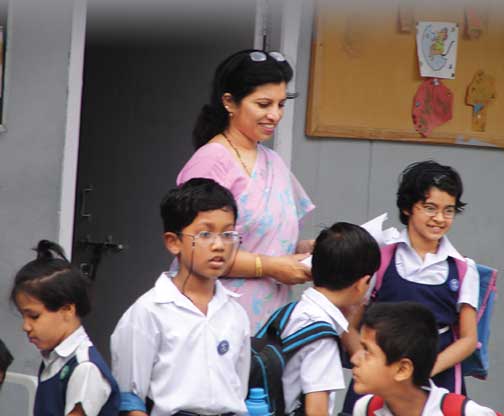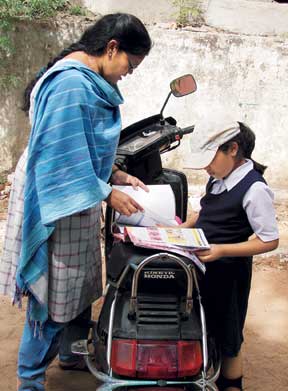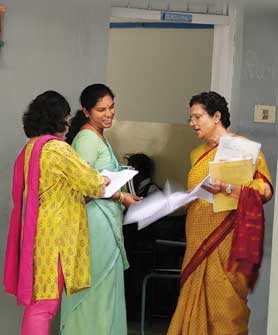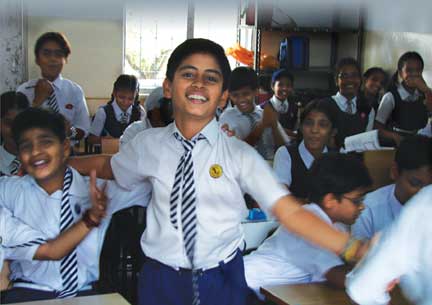Pawan Singh

From home to school and back, classroom to sports ground and back, and then finally to the examination hall, a child travels various distances to be finally considered “educated”. At home, he or she is subjected to the vigilance of parents and older siblings. At school, there are teachers to make sure he or she pays attention in class. And then there is peer pressure to ensure that education is an on-going process. Indeed the process of education is an education in itself!
The child grows up carrying the burden of report cards, diary notes, and news of parent-teacher meetings where two competing influences come in contact with each other. Sometimes, it’s all pleasant as grades narrate a tale of excellence and hence a reflection on the parental participation in the child’s education. At others, there is the humdrum noise of approval as average performers step forward with their folks to receive a bland accolade. And then there are those moments of agony and panic, confusion and conflict, and blame and denial when teachers and parents debate from opposite sides over a child’s unimpressive plight.
Where does education really begin? Is it at home where the child’s behavior on the outside is interpreted and assessed in terms of inculcation by parents and elders? Or does education actually start at school from scratch, in textbooks and notebooks, through punishments and rewards where one learns to toe a certain line? Or is it the sum total of all these experiences? It’s not an easy question to answer. However, parents and teachers remain the two main actors in a child’s development both at school and at home. Where a teacher-child and child-parent relationship forms the basis for an enriching education experience, the teacher-parent relationship can be vital in enhancing or undermining the two relationships.
How do teachers and parents interact with each other? How closely do they work together in understanding how a child learns and what his or her problems are, whether at school or at home? And how do they perceive each other’s role and involvement in ensuring that a child’s experience is not compromised? What do they expect from each other? Where the answers to these questions may highlight the areas of conflict between parents and teachers, they may also open up the scope for cooperation between them.
The parental point of view
Most parents try to make an informed decision when selecting a school for their children. Their decisions may be based on a careful assessment of various parameters such as academic culture, thrust on extracurricular activities, fee structures, reputation, etc. Minu Mathew from Bangalore whose child goes to India International School says, “Parents expect their child to get the best learning and exposure to both co-curricular and extracurricular activities. Some parents look for a more conventional kind of learning where studies are given prime importance, whereas some others look for overall development”. That is perhaps an average parent’s expectation from a school: to create a learning environment that balances the rigors of academics with participation in extracurricular activities. Prakash Pillai, another parent from Bangalore, whose son attends the St. Joseph’s Boys High School echoes this view, “Personally, I expect the school to create a well-rounded personality of my child. And as this is my most important parameter, I chose to send him to my alma mater, as it does have a reputation as a great incubator for that same parameter”.
But not everyone’s experience of what they expect from a school and what they get is similar. The choice of one’s own alma mater for parents is not uncommon owing to the familiarity of the context and also, trust and faith in the teaching methodology. Suchitra Reddy’s experience, on the contrary, was baffling when she returned from the USA and enrolled her children in her alma mater, “When I first moved back to India, I had no choice but to send my son Nihal, then 8, to my old school. The teachers didn’t seem to know what was really going on with the child. They only focused on academics and neglected most other areas vital in a child’s education”. This was not what her own experience had led her to expect.
 She recounts a specific instance that made her change her mind about the school. She said, “Nihal often didn’t want to go to school. I spoke to the teachers but they said he was doing fine and there was no problem. He would not tell me what was going on. Eventually, I found out that he was completely ostracized by his classmates because he had a different accent. Every time I’d speak to the teachers they’d say there is no problem and that he was doing absolutely fine”.
She recounts a specific instance that made her change her mind about the school. She said, “Nihal often didn’t want to go to school. I spoke to the teachers but they said he was doing fine and there was no problem. He would not tell me what was going on. Eventually, I found out that he was completely ostracized by his classmates because he had a different accent. Every time I’d speak to the teachers they’d say there is no problem and that he was doing absolutely fine”.
Such experiences can alienate both parents and children. In such situations, it’s imperative that parents and teachers communicate so that they get to the root of the problem. While one cannot wholly put the onus on teachers, parents’ concern and consequent bewilderment can cause unexpected conflicts between the two. Eventually, Reddy withdrew her son from the school and enrolled him elsewhere.
Thus emerges another important question. What do schools, and by extension, teachers expect of parents? Do they see their role as one of collaboration? Or is too much collaboration seen as interference?
From the teacher think-tank
There is often a mismatch of expectations on both sides. And lack of communication or even miscommunication can often aggravate the situation. While parent’s expectations of the teacher may be more specific, teachers do expect a basic amount of involvement and participation in routine matters related to children’s education.
Sonja Dutta, who teaches Economics at Vidyaranya High School in Hyderabad says, “There is not much interaction between the parents and teachers here in Vidyaranya, compared to other schools. Meetings only happen once or twice a year. Very few parents are as involved, and only when the academic performance of their children is not up to the mark. They do express their desire to meet more often and also take down telephone numbers but rarely ever follow up.”
Dutta’s complaint is based on the fact that parents these days have little time to spend with children. Where both parents work, it becomes even more difficult to prioritize spending time with them.
Minu Mathew expresses her inability in this regard, “I would like to enhance the learning provided by the school by reviewing whatever is taught at school. But I just don’t get the time to do it”. While others like Prakash Pillai involve themselves in the “bigger picture”. “My involvement in my son’s education is mostly on a day-to-day basis. I attend parent-teacher meetings and school events, make sure he has all the books he needs, and also the uniform”.
Then there are those parents who keenly participate in their children’s work given at school and involve themselves in the micro details of what they learn. Vijay and Sadhana Ramchander share the ways in which they work with their children. “We are pretty involved in our children’s activities. We usually talk to them after school and ask them what they did in class, or whether they have any doubts. We also help them with projects and direct them to sources of information”.
So clearly, there are different degrees of involvement on parents’ part with their children’s education. But does this involvement translate into creating a more enriching education experience for children? Do parents and teachers want different things from the child? And what happens when they negotiate what they want?
The curricular circularity
 Lakshmi, a Vidyaranya teacher and also a parent, explains the difference in expectations, “Teachers are interested in the holistic development of the student but parents are more interested in completion of syllabus and projects”.
Lakshmi, a Vidyaranya teacher and also a parent, explains the difference in expectations, “Teachers are interested in the holistic development of the student but parents are more interested in completion of syllabus and projects”.
Undoubtedly, academics are a major area of concern for most parents. The obsession over grades and marks is almost universal among most Indian parents who are worried about the future career choices of their children. They go to great lengths to ensure a competitive performance, one that would earn their child a seat in a good engineering or medical college.
Simi Nagi, Vice Principal, Pallavi Model School, Hyderabad, notes the trend in parents involvement in her school, “I’ve noticed that there is more involvement in growing stages that is classes 1 to 6. Parents get deeply involved. They read the remarks written by the teacher and pay attention to the weak subjects of the child. But when you come to classes 7 and 8, slowly that interest starts fizzling out. You’ll see that they are not very interested. Maybe they feel that the children are grown up and the onus lies on the teacher. You can also say that they are getting more career-oriented. And by the time children reach class 10, if we have 30 students in a section, hardly 10 parents come to collect the report card. And the 10 who come are not interested in the remarks written by they teacher. They only want to see the marks.”
Marks, indeed are the overriding concern. But Simi Nagi makes a further distinction: “They are only interested to see marks in Mathematics and Science. They are not bothered if the child has not done well in Social Sciences or language skills. Basic communication skills… Hindi, English, Telugu… they are not bothered!”
Undeniably, academic performance as assessed through grades and percentage points cannot be overlooked by most parents when the predominant sentiment is to pick out careers way in advance and then guide the academic course accordingly. Even though it’s an imposition of personal aspiration on the child, it has been a traditional practice – beginning as soon as the child starts school. Of course we all answered those “What do you want to be when you grow up?” questions very early on in our school life. And often the raised hands were divided between aspiring doctors and wannabe engineers without a complete realization of what it actually means to be one.
Anna Joseph, a biology teacher at Vidyaranya School observes, “Parents try to push their children into a particular career path and they get very competitive. But they forget what the philosophy of this school is”. Vidyaranya is among the few alternative schools that do not use examinations to assess the performance or potential of a student. Sonja Dutta agrees that the school is an exception when it comes to teaching methods and assessment but few parents really understand this departure.
Naina Joseph, who also teaches at Vidyaranya, feels that parents are not able to understand their child’s talent and offer guidance accordingly. She relates the case of a girl student, “There was this girl who was a very good tennis player. She often skipped classes and whenever she attended them, she was mostly lost. The parents’ attitude was to just acquire the tenth grade pass certificate for her. But when the girl was asked what she wanted, she revealed she did not want to get into competitive tennis. She is now pursuing Science in order to get into medicine.”
While for some parents academics are of paramount importance, there are others who prefer an approach that makes learning more application-oriented and not just confined to textbooks. Vijay Ramchander, for instance, advocates using a more practical approach to learning. He says, “I’d like to see more lab work through the use of models to teach science. It would really help the children to understand various scientific concepts.”
Others like Suchitra Reddy and Vinita chose Waldorf schools for their children but are not entirely happy with the school’s approach to teaching. Suchitra Reddy narrates another incident where her younger son’s class section was changed, and as a result of which, he lost all his friends. When she took up the issue with teachers, their response did not indicate any serious concern. She critiques the philosophy of Shloka, a Waldorf school in Hyderabad, “The Waldorf philosophy puts the child first but I find that it’s only partly applied. The problem is that the teachers are not trained to be so. There is a common pool of teachers that keep circulating among schools. Even some of the Waldorf teachers are from the mainstream system and they undergo some training program and become teachers. Most of them don’t have professional teaching degrees”.
Another parent, Vinita, whose son also goes to Shloka, finds their methods slightly hard to implement, “The teachers feel that academic concepts should be taught through alternative methods like storytelling. The parents should not yell at children or punish them. This is sometimes inconvenient as it is not always possible to deploy those methods”.
While some parents like Vijay, Suchitra and Vinita try to involve themselves in the details of education at school, how do the teachers feel about such a level of involvement? Do they perceive it as an encroachment on what is professionally their domain? Or do they encourage such participation without misgivings about the parents’ expertise?
Conflict and collaboration
Manju Gupta, Principal, Pallavi Model School, sees parental involvement as essentially collaborative and says, “We have an open door policy. Parents can meet teachers any time during the school time. We encourage them as far as possible to get involved in not just academic matters but also other school related issues”.
 Jasveer Kaur, a Hindi language teacher at the same school comments on the kinds of issues parents raise, “They usually take up subject-related issues like Hindi spelling and handwriting. And when we give them feedback, some parents do work closely with their children to improve weak areas. And I think often the results are visible”.
Jasveer Kaur, a Hindi language teacher at the same school comments on the kinds of issues parents raise, “They usually take up subject-related issues like Hindi spelling and handwriting. And when we give them feedback, some parents do work closely with their children to improve weak areas. And I think often the results are visible”.
Others like Naina Joseph feel a little more strongly about parental involvement, “There are certain areas where the teacher knows better and she should put her foot down and ask them firmly yet politely to not interfere”.
Meenakshi, a pre-school teacher from Mumbai, deals with parents on a more frequent basis, “I receive a number of complaints from parents. Especially from the ones who sit in class with their child. I remember this mother who would sit in class, and ask why we didn’t sing a particular song or do a particular activity on a given day. As a teacher I think I know my job and such interference is totally uncalled for. I feel that parents shouldn’t send their children to school at a young age, if they have so many issues”.
But then confl icts are ineluctable. Beyond academics, there are attitude and behaviour related issues that can turn serious and are not easily resolved.
Manju Gupta recalls a case of a new student in Pallavi Model School who had teething problems in the new school, “This girl had come from Chirec School, which happens to be a rather elite school. This girl was not able to adjust or make friends with anyone in the school. Since she was used to more facilities and infrastructure, she could not cope here. Later when she made friends, she started turning them against each other. Her mother would not admit her fault and was insistent that the school was negligent of her needs. This went on for a long time, and eventually the girl fi nished and left the school”.
Sonja Dutta was faced with a diffi cult situation when a girl in her class who had a crush on a boy wrote his name on her wrist using a blade. She was rushed to the hospital and the class teacher was blamed for the unfortunate incident. “Parents have an important role to play in a child’s development, especially in personal areas like relationships”, says Dutta.
While it’s difficult to clearly demarcate the roles to be played by teachers and parents, a collaborative relationship is possible and necessary. Conflicts arise perhaps due to the way parents and teachers view each others’ role in facilitating a child’s overall development. And without doubt, conflict resolution is the key to a more collaborative approach.
Lakshmi, whose daughter goes to a boarding school offers a unique role for parents, “If parents and teachers work as a team, many difficulties can be solved. Parents who work as professionals in different fields can visit schools and offer career-related advice to students”. Simi Nagi from Pallavi Model School on the other hand, believes in working with parents especially in nurturing special talents of the students. She says, “If we see that the child is good at quizzing, singing, or dancing, we inform the parents and ask them to work with us to hone their special talents”.
Anna Joseph feels that parents’ participation in children’s school life can help foster a work ethic in an alternative education system where the methods of assessment are different.
Manju Gupta, points out, “Both parents and teachers are on the same team. They are not working against each other. Hence a collaborative relationship can do wonders in improving the child’s schooling experience”.
However Vinita takes into consideration the practical constraints of collaboration, “There should be a distinction between areas teachers should address and those that parents should address as far as the children’s education is concerned. But then there is a lack of clear boundary between these issues as a lot of the parents are teachers themselves”.
Naina Joseph insists on involving the children in parent-teacher parleys to rule out any suspicion of a conspiracy on the child’s part. She thinks that if parents and teachers are meeting too often, then the child may get nervous and anxious as to the frequency of interaction. Hence he or she must be involved and kept in the loop so that he or she knows what’s going on.
Conclusion
So parents can be teachers while teachers also often play the role of a parent. Expertise is a matter of training oneself and while there remain some exclusive areas that either can address, collaboration can iron out kinks to a large extent. For instance, teachers can work with parents on evolving innovative methods to explain certain concepts if the latter has the knowledge and the resources. Parents could widen their range of interest in their children beyond academics by talking to them about relationships, involving them in routine decision-making and treating them as growing adults. Overlooking the fact that the child is always the primary focus of parent-teacher relationships can defeat the entire purpose of collaborating.
There is perhaps also a need to realign expectations on both sides in order to make communication more intelligible. This can be facilitated through more avenues for parent-teacher interaction. Where teachers are often accessible in schools, a greater effort is required from the parents’ side to make time to visit the school beyond the regular frequency of PTAs and school events. A general awareness of what’s going on in children’s life without causing any undue intrusion can go a long way in building a mutually productive collaborative between parents and teachers.
Ways to create the Parent-Teacher interface

- Group meetings of parents and teachers, class-wise
- One-on-one parent-teacher conferences
- Open house days when parents can walk around the school, look at children’s work, talk to teachers informally
- Parent volunteers for academic and extracurricular activities
- Parent liaison volunteers who help the school deal with various external agencies
- Guest lectures of assembly talks by parents
- Information boards to update parents and visitors about school activities
- Class newsletters from teachers to parents
- “Parent report cards” where parents can give feedback on homework and projects that children do at home
- Parent facilitators for different areas – lunch, playground, sports field, library
- Parent potluck – this can be for sections of the school, so that it doesn’t get too unwieldy
- Teacher-Parent socials – getting to know each other outside the classroom
How learning happens at home
Vijayalakshmi Ramsai
A child’s success in school strongly correlates with parental involvement, and about one half to two thirds of the variance in students’ achievement is accounted for by home variables rather than school variables.
Let us look at the role that parent involvement programs can play, and how in future we can help to meet the changing needs of school students and their families.
Parental involvement can be broadly classified as under:
- Traditional (parent as audience)
- Decision makers
- Parents as classroom volunteers
- Paid paraprofessional or teacher’s aide
- As learners
- As teachers of their own children
- Parent as home activities teacher.
Now, “How exactly does this work?” is the question from all parents!
Based on my seven years of teaching experience I can summarize it as under:
For the age group 3 to 5 years
An infant can look at pictures, listen to a parent’s voice and point to objects. Guide the child and say the name of the various objects. Children love to listen to the sounds of language before they even notice the existence of printed words. Reading books aloud to children stimulates their imagination and expands their understanding of the world. When the rhythm and melody of language become a part of a child’s life learning to read will be as natural as learning to walk and talk.
For the age group 6 to 9 years
 When parents help their children learn they open the door to a new world. All children have two wonderful resources for learning – imagination and curiosity. As parents, we have to awaken our children to the joy of learning by encouraging their imagination and curiosity.
When parents help their children learn they open the door to a new world. All children have two wonderful resources for learning – imagination and curiosity. As parents, we have to awaken our children to the joy of learning by encouraging their imagination and curiosity.
For example you and your child can; sort socks on laundry day – sorting is a major function in math and science. Cook a meal together – cooking involves not only math and science but good health as well. By doing such small things we can show that learning is fun and important.
For the age group 10 to 13 years
In this age group we can lay the foundation for becoming a life long reader.
- Read with your child and make this all important time together enjoyable.
- Stimulate your child’s interest in reading language.
- Learn about child’s school reading programs and ways to help
For the age group 14 years and above
There should be lot of comprehensive programs wherein schools should involve parents in a variety of roles. The program should be designed to
- Help parents develop skills and foster conditions at home that support learning.
- Provide parents with the knowledge of techniques to assist children in learning at home.
- Promote clear two-way communication between school and children’s progress.
- Support parents as decision-makers.
Home based involvement
This can be done in a number of ways, and two relatively easy methods are as follow:
- Regular home visit by a trained paraprofessional or a school teacher, particularly in cases where children are uncommunicative and seem to have learning difficulties.
- Carry home assignments to parents – this might include information on school events/learning opportunities / suggestions for helping students.
Parents need to be educated as to the importance of their role in education. Many parents need to be disabused of the idea that the school is the domain of the teachers and that school alone is the place for education. Learning is an experience which happens both at school and at home.
Top 5 concerns – Teachers
- Not enough parental involvement beyond academics
- Need to identify areas of behaviour improvement among children
- More trust on teachers than external tutors
- Need to distinguish own aspirations from children’s
- Parental involvement in talking about personal relationships
Top 5 concerns – Parents
- More individual attention in class
- Practical learning and teaching methods
- More professional training for teachers
- Food/Transport/Uniform
- Discipline
